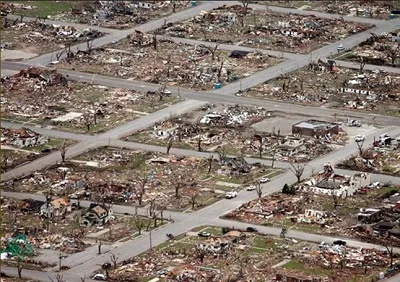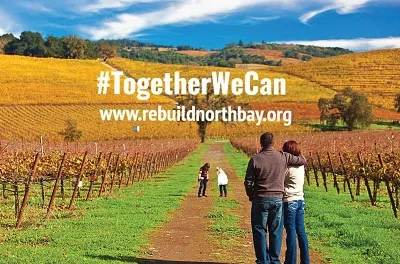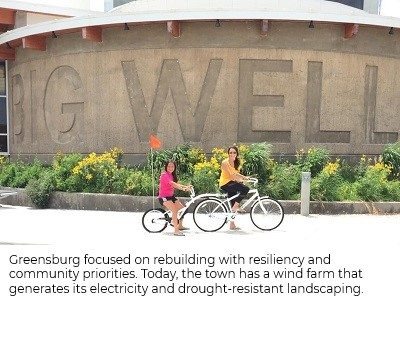When Entire Areas Disappear, How To Recover With Resilience
It was 15 years ago, in May 2007, that an EF5 tornado barreled through the 1,300-person city of Greensburg, Kansas. In just 15 minutes, give or take, 12 people were killed and 95 percent of the town was obliterated, according to Stacy Barnes, who grew up in the town and is now its administrator.
“We really had no choice but to start from the ground up,” she states. “But because we had a blank slate, we also had an opportunity. How could we rebuild for future generations? What does that look like? That conversation happened early with community leaders.”
Today, it looks like a wind farm generating all the town’s electricity, water savings from low-flow toilets and drought-resistant landscaping, and LED-powered street lights.
The devastation that tornadoes and wildfires leave in their wake is often complete. Entire neighborhoods and cities that existed a day, even an hour earlier, seemingly evaporate, leaving their residents stunned and without a manual for starting over from nothing.

That’s where experts like Zack Rosenburg come in to help community residents and leaders understand what leaders in Greensburg realized early on — that through tragedy, there can be an opportunity to rebuild for resilience. Rosenburg and Liz McCartney, who are married, co-founded SBP, an organization headquartered in New Orleans launched in 2005 after Hurricane Katrina blew through the city.
“We respond to disasters to build or rebuild houses, and we’ve done that in response to hurricanes, massive home-devastating rains, tornadoes, and wildfires,” he says. “We exist to fortify people against their breaking point after disaster.
“One way to do that is to be reactive,” explains Rosenburg. “That means rebuilding people’s houses, but you
can never get to scale that way. You can never rebuild to the full community you had before. The right action is to drive resilience and to drive planning.”
Rosenburg isn’t the only disaster recovery expert who believes the answer to rebuilding after total loss isn’t going on autopilot and attempting to recreate what once existed. Today’s momentum has shifted to reimagining first, then rebuilding.
Emergent Leaders in Demand
The first step in ensuring that what comes after a disaster is resilient, is turning to the right people for leadership. In 2021, Steven R. Norris, MAI, CRE®, principal at Norris Realty Advisors in Pasadena, Calif., who led a team called the CRE® Consulting Corps, served that role after the 2018 Camp Fire essentially razed Paradise, Calif.
Local REALTORS® feared the recovery had bogged down, and Norris’ interdisciplinary team stepped in to provide focus and guidance. Aubrey Pruis, association executive of the Paradise Association of REALTORS® commented on the process. “The team of counselors listened to our problems and concerns,” Pruis said. “We feel this project is going to change lives and give a lot of people hope. It already has.”
It was the first time Norris led a team of real estate, appraisal, development, planning and zoning experts to advise a community after a natural disaster. “But it sure won’t be the last,” he laments.
“Paradise was two years into its recovery, and rebuilding was taking a lot longer than it should have, a situation mostly having to do with the county’s wealth,” explains Norris. “Rural counties have a harder time recovering from natural disasters. Paradise’s pace of recovery was slightly above glacial, and they were getting frustrated.”
Norris believes devastated towns should quickly turn to an expert to lead their recovery. “These communities need a dealmaker who can make things happen without government burdening the process,” he says. According to Norris, that role was filled brilliantly by Jennifer Gray Thompson, CEO of the nonprofit After the Fire USA, who became an advocate for resilient rebuilding by complete accident.
In October 2017, Thompson was working for the County of Sonoma, Calif., where 11 wildfires broke out and torched 6,000 housing units the first night alone, causing 43 deaths. “Nobody had ever seen that kind of wildfire behavior before,” recalls Thompson. “Nobody knew a fire could travel a football field every three seconds. Where I live in the Sonoma Valley, it was surrounded by fire for 10 days. We had first responders, but not enough social services to support our valley of 40,000 people. So, I took on an outsized leadership role.

“An emergent leader is necessary in all disasters — we see that today,” says Thompson. “It was a terrible experience from a trauma point of view, but it was also the most amazing experience of my life. I decided that my life had to be helping this place rebuild. But the hardest thing about disaster has been that nobody showed up to tell us what to do next. I had nobody to call.”
Today, Thompson is that person. “I reached out to Paradise 10 days after the Camp Fire started,” she states. “Through my own experience, I learned the value — which I suspected would also be true in Paradise — of having someone show up who says, ‘This is terrible, but there’s hope, and you can make it through this. Here are some things that can help.’”
A ‘Make It Work’ Mindset
Norris says building for resiliency requires communities to completely rethink how they operate, including easing requirements on density, parking, and other issues tied to the zoning process.
“It should be, ‘Let’s figure this out together,’” he asserts. “You need to have independent planning consultants who can offer ideas catalytic to development, and there needs to be a ‘let’s get it done attitude’ in city hall. It’s not about a grand building project. It’s about what can be done to get people hammering nails right way.”
“People need to be entrepreneurial, and this is where the dealmaker comes in,” he adds. “It’s going to take work, and you’ll need things like zoning changes. It’s a world-view issue I see all the time. There are entrepreneurial people who want to get things done and bureaucratic people who follow the rules. Someone needs to sit them all down and get them to come to the middle.”
Rosenburg couldn’t agree more. “The only way to be resilient is to intentionally rebuild for the next disaster,” he says. “There has to be adherence to, and focus on, building standards and codes. That said, cities and states have to streamline the process with simplicity. Whether it’s using technology, looking at their whole processes again, or understanding what’s essential and what’s nice to have — the humanity of the people who need to move home has to be elevated above ‘we’ve always done it this way’ thinking.”
“I think there’s no better example than New York City’s response to Hurricane Sandy,” he adds. “I’d say reconstruction costs doubled because of the arcane permitting process in New York and the lack of appetite to look at things differently.”
Speed is also critical to resilient rebuilding. A sluggish recovery means people will plant roots elsewhere, causing the community to struggle to regrow.
“Three things determine whether people are going to be pushed beyond their breaking point,” explains Rosenburg. “The time between the disaster and recovery, the unpredictability of the process, and the lack of access to resources. Leaders have to answer pretty quickly the equation they’re solving. What’s ‘N’ in that equation? How many houses were lost? What’s the total cost? What’s the plan moving forward? People can deal with the time it takes to recover if they have a predictable path forward.”
Barnes agrees but also advises against haste. “You don’t want to rush and to make quick emotional decisions you later regret,” she says. “Two things were pivotal in our community — getting our temporary school up in time for kids to start school in August and Federal Emergency Management Agency putting in a temporary trailer park that provided housing in the community. Those things in the first couple of months were critical to getting people back to the community.”
Rosenburg says enabling states and FEMA to use flyover imagery and BigData to determine compensation would be faster — and more consistent and predictable — than today’s practice of sending adjusters door to door.
That brings up two other factors Rosenburg says can’t be ignored in rebuilding for resiliency — affordability and equity. “One thing we saw was that, after disasters, people were essentialized by how they paid for their house,” he states. “You’re either a renter or a homeowner, and renters didn’t even come second. Even for people who own homes, lower-income people and folks of color are often less able to withstand the delay until federal money arrives. We’re working deeply on systemwide approaches.”
Materials Make a Difference
Of course, as rebuilding happens, communities should focus on building materials that both prevent and withstand future disasters.
Experts say strengthening construction isn’t cost prohibitive. “It’s not much more expensive,” says Elizabeth Hausler, founder and CEO of Denver-based Build Change, whose mission is to ensure that communities and cities build resilience. The damage from the nearby 2021-2022 Marshall Fire in Boulder, Colo., which killed two people and destroyed more than 1,000 structures, has heightened the resiliency issue for her.
“Affordability is a challenge to start with, but the improvements in building materials that could be done should be affordable for most,” she explains. “We’re not talking about huge amounts of money.”

In Greensburg, many residents rebuilt for the next tornado. “A lot of people took extra steps to build safe rooms where they didn’t have them before,” says Barnes. “Hopefully, they never have to test those.”
When it comes to rebuilding for fire resistance, Thompson preaches things like Vulcan vents, which block embers from entering homes; Hardie board siding; and metal roofs. She adds that residents who had at least of five feet of clearance between their home and flammable materials have fared better in wildfires.
Whether it’s to withstand fire or wind, Hausler stresses three Cs: configuration, connections, and construction material quality. “Configuration refers to things like a building with a big, long overhang, where wind will get caught under the underhang and blow off the roof,” she explains. “It’s also about things like connecting or disconnecting carports.”
“Also, everything has to be securely connected together, which is especially important for wind and not so much for fire,” adds Hausler. “You might have a sturdy set of masonry walls, but the roof isn’t adequately anchored and tied down to the walls.”
Then there’s the quality of building materials. In Hausler’s ideal world, rebuilding would shift away from timber and wood-based buildings to masonry and concrete, which don’t burn and stay put in the strongest high-wind events.
“The argument today is that timber is much more sustainable because concrete and production of cement produces carbon dioxide,” she explains. “However, in a fire, the timber building will burn down and generate a huge amount of CO2 emissions, while concrete won’t. So, there’s a tension between sustainability and disaster resilience.”
Hausler acknowledges, however, that ship may have sailed in the United States, with its huge appetite for wood-frame construction. That said, other materials can be substituted for resiliency, such as roof shingles made from recycled tires or ceramic clay tile.
“For my house in Colorado, which is wood frame, I’m looking at replacing my wood shingles with a more fire-resistant roof,” she notes. “It’s probably going to be more expensive, but I think it will matter most in reducing the chance my home will catch fire.
“Some developers will use the cheapest materials they’re allowed to use,” she says. “So, homeowners need to demand higher-quality building materials, and insurance companies need to give incentives like lower premiums for those products to be used.”
Hausler points consumers to “The Buyer’s Guide to Resilient Homes” [buyersguidetoresilienthomes.org/] from the Federal Alliance of Safe Homes.
Government entities could also provide incentives and streamline processes to help communities rebuild more resiliently. “I’d like to see governments waive impact fees and provide one-stop permitting,” says Thompson. “I’d also like to see the federal government have one approach for all federal grants. We’ve seen huge strides made due to COVID-19. FEMA and the Small Business Administration are showing what they can do quickly.”
Rosenburg is advocating for a bridge loan program that would lend to residents in disaster-devastated areas until federal dollars arrive. “Right now, people can be reimbursed if they spend their own money and they qualify for reimbursement,” he explains. “That’s horrible for people who can’t spend their own money.”
The entire focus for governments should be offering carrots rather than sticks. “If the message is, ‘You should do these things to rebuild resiliently and it’s going to cost more,’ without providing any subsidy, it’s going to be tough for communities,” says Hausler. “We work in partnership with governments and other institutions that can provide incentives. There are programs out there that do this, but they need to be universalized.”
Ultimately, while government incentives can help drive resilience, Barnes says it all comes back to the community itself. “It’s good to have outside help, but knowing who your community is, what your needs are, and how to build for the future is critical,” she says. “You’re the ones who are going to live there.”
REALTORS® Take the Lead in Wildfire Prevention
Across the nation, REALTORS® are integral in building resilient neighborhoods. And their work with consumers during the homebuying process can be a huge part of education before and after natural disasters.
Oregon’s Rogue Valley Association of REALTORS® (RVAR) has stepped up on wildfire prevention. In September 2020, the organization’s CEO, Tina Grimes, was completing the work the RVAR was doing with the city of Ashland, OR, to create wildfire prevention materials when a wildfire swept through two cities just north of Ashland.
More than 2,800 structures in the Talent and Phoenix communities were destroyed in what was named the Almeda Fire. Jefferson Public Radio called it “the most destructive wildfire in Oregon’s recorded history.”
After some stunned utterances to herself, Grimes determined that, given the level of devastation, it was best to hold off on the program’s launch. In Spring 2021, the RVAR and city of Ashland, OR, published a website [ashland.or.us/SectionIndex.asp?SectionID=539] and brochure educating residents about ways to protect their homes and businesses from wildfires.
“It explains the right kinds of landscaping, fencing materials, and roofing,” she states. “It’s specific to the city of Ashland, and this year we’ll rebrand it and expand it to other fire districts in the area. We also created a form REALTORS® can use with buyer or seller clients to make them aware that the entire city is a fire zone, what that means to them, and the steps they can take to make their home more defensive against wildfires. Many of our members have thanked us for creating the form because it helps them have a necessary conversation with their clients.”
RVAR also funded two-day training on fire-wise properties presented by the National Fire Prevention Association for local home inspectors.
The entire program cost $33,000 and was funded by an NAR consumer advocacy grant [realtorparty.realtor/about-us/rvar-consumer-0921]. “We’re committed to amping up the training with REALTORS® on the form they can use and reaching back out to inspectors to advertise fire-wise information as a service they can provide,” says Grimes.
Leaders at other REALTOR® associations have reached out to see if RVAR will share its materials with them. “We’re a very rural, forested area,” she notes. “What happened in our area in 2020 was unique, but every summer, we have wildfires, and we have people on evacuation alerts. So, this will be a two- to three-year push. And wildfires are a big problem in all western states, from the Rockies to the coast.”
